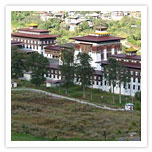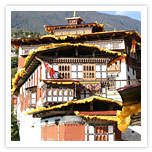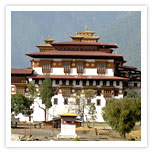Tours to Bhutan, Travel to Bhutan
- Bhutan Visitor Info
- Western Region Bhutan -
- Central Region Bhutan -
- Eastern Region Bhutan -
- Festivals of Bhutan -
- National symbols -
- History of Bhutan -
- Culture of Bhutan -
- Religion of Bhutan -
- People of Bhutan -
- Bhutan Visa & Customs -
- Bhutan Accommodation -
- Bhutan Transportation -
- Climate of Bhutan -
- Currency of Bhutan -
- Paro Festival Bhutan -
- Trekking in Bhutan -
BHUTAN - GLIMPSES OF BHUTAN (08 DAYS)
For further Details Contact Us
Places covered : Paro - Thimphu - Wangdue - Trongsa - Gangtey - Punakha - Paro
Highlights of Glimpses of Bhutan
Thimphu : Memorial Chorten, Folk and Textile Museum, Sitting Buddha, Tashichhodzong.
Trongsa : Ta Dzong , Trongsa Dzong.
Gangtey : Gangtey valley , Nyingmapa.
Punakha : Punakha Dzong , Queen Ashi Dorji Wangmo Wangchuk , Simthoka Dzong.
Wangdue
: Dochu La Pass , Wangdue valley , Wangdue Dzong , Chendebji Chorten.
 Day
01. ARRIVE PARO AND PROCEED TO THIMPHU
Day
01. ARRIVE PARO AND PROCEED TO THIMPHU
This morning ensure to be at airport at least 02 hours before the flight departure time. You will be met on arrival by your tour guide who will then escort you to Thimphu. The road to Thimphu runs down through the valley, to Chuzom (Confluence) at the entrance of the valley, where the Paro – Thimphu rivers meet. Three Chorten’s of different style mark the confluence of these 02 rivers. Shorty before reaching Chuzom, you will see on your left Tschogang Lhakhang, ‘the temple of the excellent horse’. It is a private temple, built in 15th century, as the result of visitation from Balaha, the excellent horse, a manifestation of Chenrezig, the compassionate Buddha. The road passes along a narrow valley with high, rocky cliffs on the left, and then the valley opens out into farmland on the approach to Thimphu. Upon arrival in Thimphu relax for a while and acclimatize or walk around the town to get the feel of it.
Stay overnight in Thimphu.
Day 02. IN THIMPHU.
This morning start the tour of Thimphu city with a visit to Memorial Chorten built in memory of the lake King; visit the Folk & Textile museum; School of Fine Arts (Thangka painting and other traditional arts) where the traditional arts are being revived by the Government; Indigenous Medicine Hospital, where herbal medicine, acupuncture and the ancient art of healing that was passed down from Tibet is still being practiced today; Statue of sitting Buddha the biggest in Bhutan and Sangay point to have a bird’s eye of the Thimphu valley. Later in afternoon visit Changgangkha temples, Drub throb nunnery; and then visit Tashichhodzong, seat of the Royal Government and Central Monastic Body. It was rebuilt in the early 1960’s after a fire destroyed most of the building. The amazing thing about this building is that it was built without a single drawing or a single nail
Stay overnight in Thimphu.  Day 03. THIMPHU – DOCHULA PASS – PHOBJIKHA VALLEY
Day 03. THIMPHU – DOCHULA PASS – PHOBJIKHA VALLEY
This morning take a scenic drive on the mountain route to Phobjikha Valley passing through Dochula pass at 10000ft. Soon you reach Dochula Pass at 10,000 feet where a large Chorten and a forest of prayer flags greet you. On a clear day you can view an endless chain of Himalayan Peaks such as Gangar Punsum (24,000 ft), the highest unclimbed peak in the world, Ganchenta, Teri gang, Table Mountain among other all above 20,000 ft. From there you descend 5500 ft through temperate forests coloured with rhododendrons and magnolias down to the semitropical zone of oranges, banana and cactuses. Stop at Dochula pass for a cup of coffee/tea and if it’s a clear sky you will get to see the beautiful mountain ranges. After the coffee, drive further to Phobjikha valley. It is one of the little visited Phobjikha valleys near the village of Gangtey, which houses Gangtey Goemba (Monastery). The valley is part of the Black Mountains National Park, one of the Bhutan’s most important wildlife sanctuaries. Each winter it is home to a flock of 300 rare and endangered black-necked cranes, which arrive from Tibet. Shepherds and nomadic yak-herders mainly inhabit the surrounding Black Mountains. Gangtey Goemba overlooks the large green expanse of the Phobjikha valley. Visit RSPN (Royal Society for Protection of Nature), it’s open from 7 am – 7 pm, Monday to Friday. It has formative displays about the cranes and the valley environment
Stay overnight in
Gangtey.
Day 04. PHOBJIKHA VALLEY – PUNAKHA
Today early morning enjoy a nature walk and then return to hotel for breakfast and then drive down to Punakha. Upon arrival, walk up for 30 minutes or so to Chimmi Lhakhang situated near the river on a small plateau. It was built by the famous "divine madman" Drukpa Kuenley; a famous pilgrim site for infertile women who wish to bear children. Check-in at the hotel of your stay and then visit the Punakha Dzong, the winter residence of the Je Khenpo and the monks of Tashichhodzong. The Dzong is situated at the confluence of two mighty glacial rivers, the Mo Chu and Pa Chu, which descend from the lofty heights of the Himalayas, and was the capital of the kingdom in olden times.
Stay overnight in Trongsa.
Day 05. PUNAKHA – SEMTHOKA DZONG – PARO
This morning drive back to Paro enroute stopping at Semthoka Dzong. Shabdrung Ngawang Namgyal was one of the greatest builders of Dzong in Bhutan. To consolidate his newly acquired domain in western Bhutan and to defend himself from both the internal foes and external enemies he started constructing this Dzong. The present place where the Dzong stands is at the boundary common to three prominent western regions: Sha (Wangdiphodrang), Wang (Thimphu) and Pa (Paro). Continue the drive to Paro and upon arrival visit Ta Dzong, originally built as watchtower and now houses the National museum. The extensive collection included antique Thangka paintings, textiles, weapons & armor, household object and a rich assortment of the natural and historic artifacts. (Note: Ta Dzong/Museum is closed on every Sunday and Monday).
Check-in at the hotel of your stay and later in the afternoon take a short drive to northern part of the valley to visit to Drukgyel Dzong ruins that was once a strategic post to withhold invading Tibetan forces from the north. Also visit the temples of Kichu Lhakhang.

Stay overnight in Paro.
Day 06.
PARO.
This morning hike up to Taktsang monastery (The Tiger’s Nest), for people unaccustomed to the altitude it takes about three hours at an average walking speed to reach the temples. Enroute stop at teahouse for a refreshing drink and have an excellent view of the monastery. The path may at times appear to somewhat hair-raising but it is well defined and there is no danger whatever of falling off. Taktsang monastery is one of the most venerated pilgrim sites of the Himalayan world and it contains 13 holy places. Taktsang, the “Tiger’s Lair”, gets its name from the story of its foundation. In the 8th century, Guru Rinpoche came to Taktsang in a miraculous manner, flying on the back of a tigress from Khenpajong in the region of Kurteop. According to Bhutanese tradition, the tigress was a form taken by one of the Master’s consorts for the occasion. Guru Rinpoche meditated for three months in a cave at Taktsang and converted the Paro valley to Buddhism. The evening is free for you to walk around the town.
Stay overnight in Paro.
Day 07. IN PARO
This morning take an excursion to HAA District which was restricted at one point of time. You will pass through Chelela Pass at 13000ft and weather permitting you will have a clear view of Mt. Jumohlari Peak. Enroute you will get to visit beautiful temple and a local village. After spending sometime in this beautiful valley return to Paro town and walk around on your own
Stay overnight in Paro.
Day 08. LEAVE PARO
This morning in time proceed to airport to board flight for onward destination.






